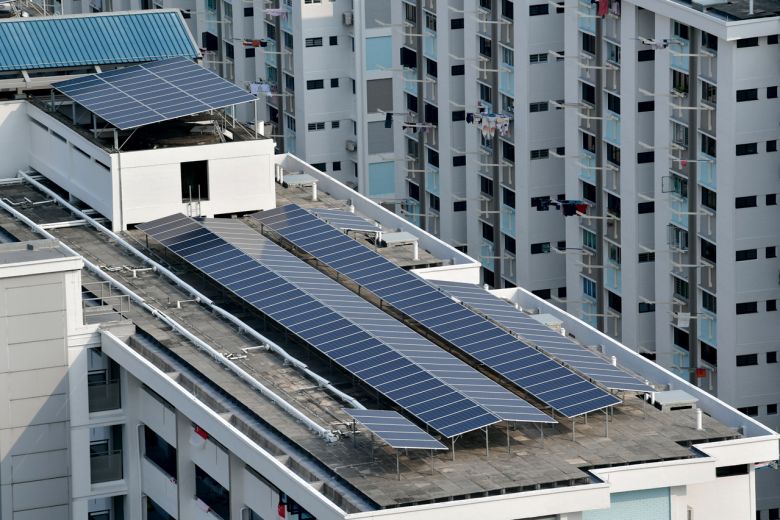HDB aims to more than double solar capacity by 2030
Tender launched to install solar panels in 1,154 more housing blocks, 46 govt sites
Sign up now: Get ST's newsletters delivered to your inbox

Solar panels on the rooftop of a Housing & Development Board (HDB) block in Ang Mo Kio. The HDB plans to more than double its capacity for solar power by 2030.
PHOTO: ST FILE
Follow topic:
Leading the charge to generate more clean energy in Singapore, the Housing Board (HDB) plans to more than double its capacity for solar power by 2030.
Its new target announced yesterday means that over the next 10 years, it will have the solar capacity to power the equivalent of about 135,000 four-room flats with clean energy.
The HDB remains the biggest driver of Singapore's solar push, with the Republic having pledged to ramp up its clean energy generation and cut back its carbon emissions as part of global efforts to fight climate change.
These remain on track, with the HDB already having exceeded its previous target of 220 megawatt-peak (MWp) by next year - the equivalent of powering 55,000 four-room flats.
The new targets significantly raise the bar for both the HDB and Singapore, and will involve installing solar panels across more HDB blocks.
The efforts are being aided by advances in technology which allow more solar energy to be generated from the same amount of space on HDB rooftops.
HDB's new target of 540MWp by 2030 can reduce carbon emissions by 324,000 tonnes per year.
As part of its wider clean energy drive, Singapore has pledged to ramp up its overall solar capacity by more than seven times from current levels, to at least two gigawatt-peak (GWp) by 2030. This is enough to meet about 4 per cent of Singapore's total electricity demand today.
324k
Tonnes of carbon emissions HDB can reduce each year if it meets its new solar capacity target by 2030.
4%
Percentage of Singapore's total electricity demand today that can be met with solar power, if capacity is ramped up to at least two gigawatt-peak by 2030.
To achieve its targets, the HDB has launched a tender to install solar panels across 1,154 HDB blocks and 46 government sites such as schools.
The latest tender will reap 60MWp of solar energy islandwide.
It comes under the HDB and Economic Development Board's SolarNova programme, which compiles solar demand from various agencies to enjoy economies of scale.
Six agencies are participating in this tender, which closes on March 2 and is targeted to be awarded in the third quarter of next year.
The installation of the solar photovoltaic systems is expected to be completed by the first quarter of 2023.
The previous tender, awarded to local clean energy firm Sunseap, involved 1,218 HDB blocks and 49 government sites.
As of this month, about 2,060 HDB blocks have been fitted with solar panels, and installation at another 2,500 blocks or so is in progress. The solar energy harnessed is used to power common services such as lifts, lights and water pumps.
On average, these HDB blocks are able to achieve net-zero energy consumption in common areas, which means the building produces more energy than it consumes. Excess solar energy is channelled back to Singapore's electrical grid.
HDB aims to install solar panels on about 10,000 blocks, where feasible. More efficient solar panels can now convert around 20 per cent of sunlight into electricity, compared with 16 per cent previously. This has enabled previously unsuitable rooftop spaces such as those at point blocks and partially shaded areas to now be installed with solar panels.
Professor Subodh Mhaisalkar, executive director for the Energy Research Institute at the Nanyang Technological University, hopes other players will follow HDB's lead.
"Globally, solar power is either in solar farms or low-rise homes and buildings. HDB rooftop solar panels give validation that solar power in a high-rise environment is possible," he said.

